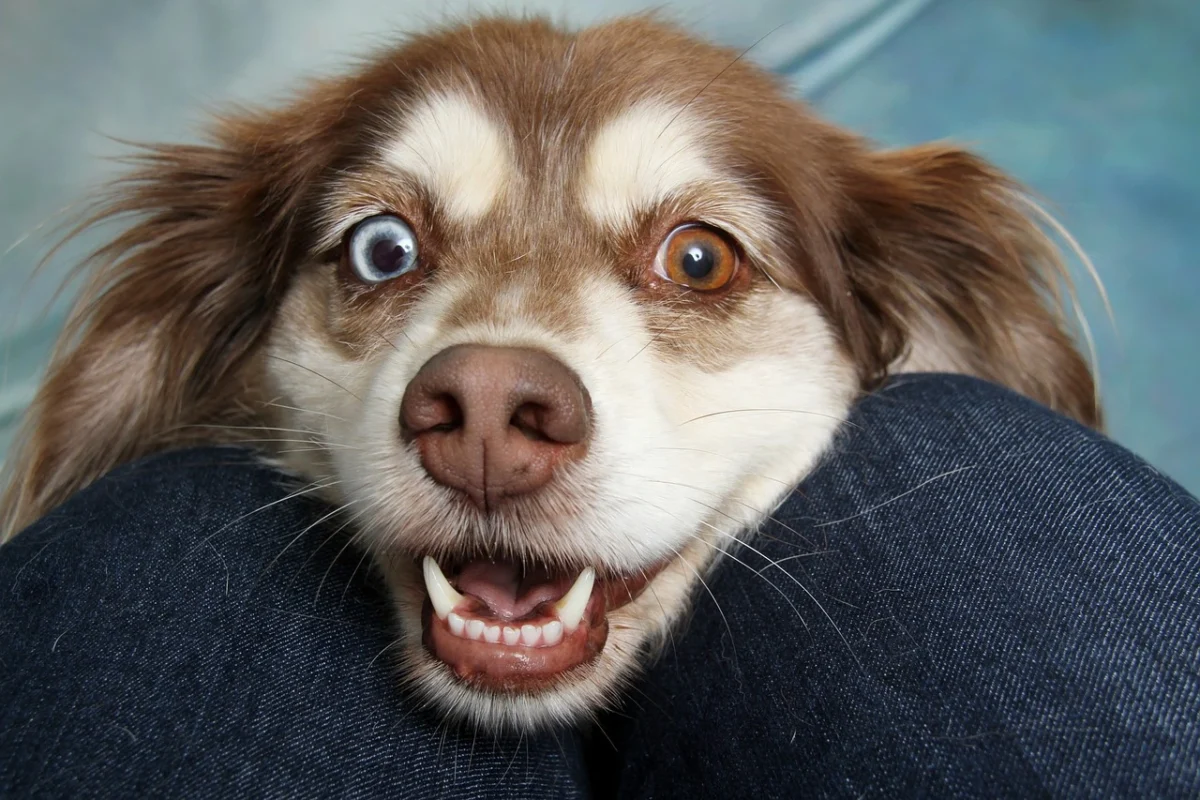Domestic Animals
Why Does My Dog Sleep Between My Legs?

Last Updated on February 13, 2024 by israel olaniran
Have you ever settled into bed, only to find your furry friend nestled snugly between your legs, claiming their cozy spot for the night? It’s a common scenario that many dog owners experience. In this article, we’re delving into the intriguing behavior of why dogs often choose to snooze between their human’s legs. From the warmth of companionship to ancestral instincts, we’ll unravel the reasons behind this endearing canine quirk.
Read: why does my dog sit on my feet?
Why Does My Dog Sleep Between My Legs?
Picture this: You’re getting ready to settle down for a good night’s sleep, and suddenly, your furry companion plops down right between your legs. While it might seem like a peculiar choice, this behavior is rooted in a mix of natural instincts and emotional connections.
1. Comfort
Dogs are social creatures, and they thrive on companionship. Sleeping between your legs provides a sense of security and comfort, allowing them to feel close to you. Your legs act as a warm and snug cocoon, enveloping your pup in a sense of safety.
Read: are dogs stronger than cats?
2. Security and Bonding
Just as a child seeks the protective embrace of a parent, dogs seek security by sleeping near their trusted human. The proximity fosters a stronger bond, reassuring them that they are part of a loving pack.
Read: do dogs have lips?
3. Temperature Regulation
Dogs are sensitive to temperature changes, and snuggling between your legs helps them regulate their body heat. Your legs emit a steady warmth that can be incredibly soothing, especially during cooler nights.
Read: why do dogs look away when you eat?
🐾 Are you a dog owner who wants to ensure your dog gets the absolute best in terms of nutrition?
4. Instincts
In the wild, canines would huddle together for warmth and protection. This instinctual behavior is carried through generations, and your dog’s choice to sleep between your legs mirrors this ancient practice.
Read: how many bones does a dog have?
5. Scent
Your scent is like a familiar, comforting blanket to your dog. By sleeping between your legs, they surround themselves with your scent, creating a cozy and secure sleeping space.
Read: can drug dogs smell nicotine?
6. Sensory Stimulation
Dogs experience the world through their senses. Sleeping between your legs exposes them to a variety of scents, sounds, and subtle movements, providing mental stimulation even while they sleep.
Read: why does my dog lay on me?
7. Pack Mentality
Dogs are pack animals, and in a pack, sleeping close together reinforces social bonds. By sleeping between your legs, your dog is embracing their role within your family “pack.”
8. Sleeping Patterns
Dogs have sleep cycles similar to humans, including periods of deep sleep and REM sleep. Sleeping between your legs may offer a sense of reassurance during vulnerable sleep phases.
Understanding Your Dog’s Behavior
While the reasons for this behavior are multifaceted, it ultimately boils down to your dog’s deep-rooted need for companionship, security, and warmth. Observing your dog’s body language and preferences can provide further insight into their motives.
Creating Alternative Sleeping Spaces
If you’re concerned about your dog’s constant presence between your legs, consider providing alternative comfortable sleeping spots. This encourages independence while still catering to their need for coziness.
Encouraging Independent Sleeping
Gently encouraging your dog to sleep in their own space can be achieved through positive reinforcement and gradual adjustments. A comfy dog bed or blanket can work wonders.
Training Tips
Basic commands like “stay” and “bed” can be helpful in guiding your dog to their designated sleeping area. Consistency and patience are key in reinforcing these commands.
Seeking Veterinary Advice
If your dog’s sleeping behavior changes suddenly or is accompanied by signs of discomfort, it’s wise to consult a veterinarian. Physical discomfort or underlying health issues could be contributing factors.
Is it okay to let my dog sleep between my legs every night?
Absolutely, as long as it’s comfortable for both you and your dog. However, providing alternative sleeping options can offer more flexibility.
Why does my dog only sleep between my legs and not with other family members?
Dogs often form strongest bonds with one particular family member, and your scent and companionship could be the primary reasons.
Should I be concerned if my dog suddenly stops sleeping between my legs?
It’s worth observing their behavior. Sudden changes could indicate underlying health issues, so consulting a vet might be a good idea.
How can I train my dog to sleep in their own bed?
Start with positive reinforcement and gradual adjustments. Reward them for using their bed and encourage them with gentle commands.
Are certain dog breeds more prone to sleeping between their owner’s legs?
While it varies from dog to dog, breeds with strong bonding tendencies might be more inclined to cozy up between your legs.
How do I know if my dog loves me?
Dogs show love and affection through various behaviors, such as wagging their tails, licking, cuddling, and following you around. Sleeping close to you, including between your legs, is another way your dog expresses their love and attachment.
Why does my dog have to be touching me when he sleeps?
Physical contact is a way for dogs to maintain a sense of connection and security. When your dog sleeps while touching you, it reinforces their emotional bond and provides them comfort, similar to how a hug or cuddle makes humans feel safe and loved.
Why does my dog sleep facing away from me?
Sleeping facing away from you might be your dog’s way of balancing the need for personal space with the desire to stay connected. It allows them to rest comfortably while still being aware of your presence.
Why does my dog sleep behind my knees?
Sleeping behind your knees could be a strategic position that offers both physical warmth and protection. Your legs provide a sheltered spot where your dog can relax while keeping an eye on their surroundings.
Why does my dog sleep in between me and my husband?
Dogs often choose to sleep between their owners for companionship and a sense of security. If your dog sleeps between you and your husband, it’s likely they feel comfortable and loved by both of you, enjoying the warmth and closeness.
Why does my dog sleep at my feet instead of next to me?
Sleeping at your feet might be your dog’s way of showing respect for your space while still being near you. This position can also be comforting for dogs, as they can rest and keep watch over their environment at the same time.
Final Thoughts On Why Does My Dog Sleep Between My Legs
The charming habit of dogs sleeping between their human’s legs is a testament to the deep bonds we share with our four-legged companions. From warmth and security to ancient instincts and emotional connections, this behavior highlights the intricate relationship between humans and their furry friends.
Domestic Animals
30 Fascinating Facts About Dogs You Probably Didn’t Know.

Last Updated on March 25, 2024 by israel olaniran
We all love dogs, yeah? But how well do we know this beautiful creatures, Here are 30 fascinating facts you probably didn’t know about dogs, Add anyone you know in the comment section.
30 Fascinating Facts About Dogs
- 1. Dogs are descendants of wolves and were domesticated by humans thousands of years ago.
- 2. There are hundreds of dog breeds, each with its own unique characteristics and traits.
- 3. The Basenji dog breed is known as the “barkless dog” because it produces a unique yodel-like sound instead of barking.
- 4. Dogs have an incredible sense of smell and can detect scents at concentrations as low as parts per trillion.
- 5. The Labrador Retriever is one of the most popular dog breeds in the world, known for its friendly and outgoing personality.
- 6. Dogs have three eyelids: an upper lid, a lower lid, and a third lid called the nictitating membrane, which helps keep their eyes moist and protected.
- 7. The Border Collie is considered one of the most intelligent dog breeds and excels in activities like agility, herding, and obedience.
- 8. Dogs have sweat glands only in their paw pads, so they primarily regulate their body temperature by panting.
- 9. The Chihuahua is the smallest dog breed in the world, with some individuals weighing less than 2 pounds.
- 10. Dogs have a highly developed sense of hearing and can detect sounds at frequencies much higher than humans.

- 11. The Australian Cattle Dog was bred to herd cattle and is known for its intelligence, agility, and endurance.
- 12. Dogs have an average lifespan of 10 to 15 years, although this varies depending on the breed and size of the dog.
- 13. The Greyhound is one of the fastest dog breeds, capable of reaching speeds up to 45 miles per hour.
- 14. Dogs have a “third eyelid” called the nictitating membrane, which helps keep their eyes moist and protected.
- 15. The Dalmatian breed is famous for its distinctive black or liver spotted coat.
- 16. Dogs are social animals that thrive on companionship and interaction with humans and other animals.
- 17. The Siberian Husky is known for its endurance and ability to withstand cold temperatures.
- 18. Dogs have an excellent sense of taste, with taste buds not only on their tongues but also on the roofs of their mouths and the back of their throats.
- 19. The Beagle is known for its keen sense of smell and is often used in scent detection work.
- 20. Dogs have a unique set of vocalizations, including barking, howling, whining, and growling, to communicate with humans and other dogs.
Read: 30 interesting facts about lovebirds.
- 21. The Golden Retriever is a popular breed known for its friendly and gentle temperament, making it an excellent family pet.
- 22. Dogs have an innate sense of hierarchy and social structure within their packs, which can influence their behavior and interactions with other dogs and humans.
- 23. The Poodle is known for its intelligence and hypoallergenic coat, making it a popular choice for people with allergies.
- 24. Dogs have an incredible sense of direction and can navigate using landmarks, scents, and celestial cues.
- 25. The Bulldog breed is characterized by its loose, wrinkled skin, distinctive pushed-in nose, and muscular build.
- 26. Dogs are capable of forming strong bonds with their human companions and are known for their loyalty and devotion.
- 27. The German Shepherd is a versatile and intelligent breed often used in roles such as police work, search and rescue, and therapy.
- 28. Dogs have whiskers, or vibrissae, located on their muzzle, eyebrows, and chin, which help them sense vibrations and navigate in dim light.
- 29. The Shih Tzu is a small breed known for its long, flowing coat and friendly disposition.
- 30. Dogs communicate using a combination of body language, vocalizations, and facial expressions to convey their emotions, needs, and intentions.
How many of them did you know? Tell us
-
Domestic Animals2 years ago
Why Do Dogs Look Away When You Eat
-
Domestic Animals6 months ago
Small But Smart: 10 Most Intelligent Small Dog Breeds
-
Wild Animals2 years ago
What Does Snake Poop Look Like? PICTURES & VIDEOS
-
Pet News6 months ago
Trending Now: Woman Raised A Panther Thinking It Was A Cat.
-
Domestic Animals8 months ago
Why Does My Cat Sleep On My Feet? Best Reasons
-
Insects7 months ago
Australian Stick Bug: ALL You Need To Know.
-
Domestic Animals1 year ago
Can Guinea Pigs Eat Oranges? ALL You Need To Know!
-
Domestic Animals2 years ago
Can Guinea Pigs Eat Pears? All You Need To Know (2023)






















